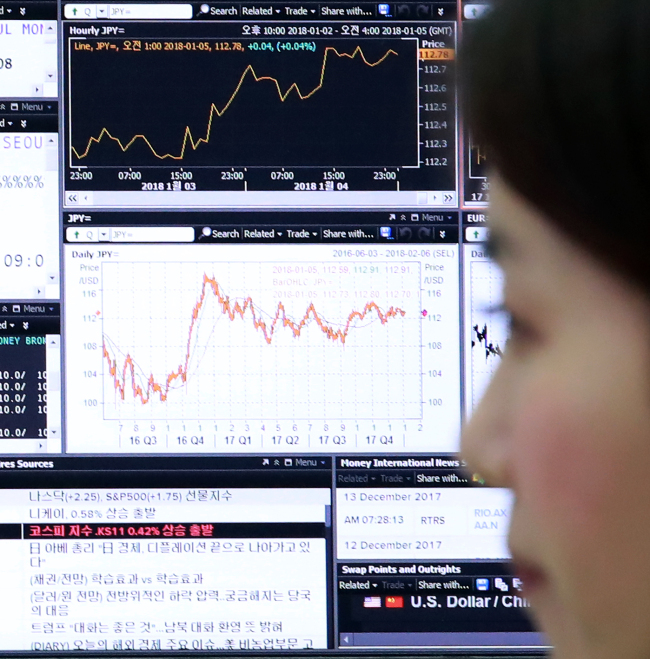The prospects of a simultaneous rise in the value of the won, interest rates and oil prices are casting a shadow on the government’s expectation that the Korean economy will grow more than 3 percent this year, propelled by a continuous rise in exports and a rebound in domestic demand.
Trade officials here worry that such upward trends might be coupled with lingering uncertainties in the financial market and rising global protectionism to make it hard to achieve the export growth target for 2018 set at over 4 percent. Korea saw its outbound shipments increase 15.8 percent from a year earlier to an all-time high of $573.9 billion last year on the back of an upturn in global demand for its major export goods, particularly memory chips.
The most immediate and serious concern for the country’s exporters now is the steep appreciation of the local currency against the US dollar.
The won appreciated 12.8 percent against the greenback last year, the highest annual gain in 13 years.
The won strengthened to a three-year record, down to 1,061.2 won per dollar on Jan. 2 before weakening slightly in the following days.

(Yonhap)
Some analysts expect the rate to drop below 1,000 won in the first half of the year if geopolitical risks on the Korean Peninsula ease. Also behind the strengthening of the won is the perception that monetary authorities here will be limited in interfering in the foreign exchange market as Korea is under the US Treasury Department’s close watch for possible currency manipulation.
A stronger won will significantly undermine the price competitiveness of Korean manufacturing exporters, including car and chip makers.
Industry officials project the country’s auto companies will begin suffering loss from shipments abroad if the won-dollar exchange rate strengthens to 1,050 won.
A 10 percent fall in the rate is estimated to reduce the operating profits of Samsung Electronics, the world’s largest chip manufacturer, by 2-3 percent.
Small and medium-sized enterprises remain particularly vulnerable to the fallout from a strengthening won.
Nearly 70 percent of 514 SME exporters surveyed last month by the Institute for International Trade set the average won-dollar exchange rate at a range between 1,075 won and 1,175 won in drawing up 2018 business plans. About half were not prepared at all for fluctuations beyond supposed ranges.
“It is necessary for the government to expand support for SME exporters within the boundaries of World Trade Organization rules and send a more positive signal on stabilizing the foreign exchange market,” said Noh Min-sun, a researcher at the Korea Small Business Institute.
With the strengthening of the won coupled with rising oil prices and the possibility of additional interest rate hikes, uncertainties in the business environment surrounding local firms are being amplified.
“Throughout the year, consideration may have to be given to whether to revise our management plan,” a corporate executive said, asking not to be named.
The Bank of Korea is expected to raise its key interest rate, which has been set at 1.5 percent since November, a couple of times by 0.25 percentage points this year.
The increase may be steeper to avoid a reversal of rates in Korea and the US, which would prompt a capital outflow.
The US Federal Reserve is seen to tilt toward three to four additional rate hikes this year following its decision in December to raise its benchmark rate to a target range of 1.25 percent to 1.5 percent.
Higher interest rates would increase the burden on Korean companies, which unlike their peers in the US and other major economies, have been troubled with anti-business policies at home, including a rise in the maximum corporate tax rate from 22 percent to 25 percent.
Consumer spending may decrease due to rate hikes that will increase interest payments on mounting household debt, dampening corporate production and investment. The country’s household debt exceeded 1,400 trillion won ($1.31 trillion) last year.
Rising oil prices could further hold down consumption expenditure by raising the price of imported goods and reducing disposable household income.
International crude oil prices soared for five consecutive trading days last week to a three-year high -- $64.30 per barrel for West Texas Intermediate, $66.36 for Dubai and $69.87 for Brent.
Recent oil price hikes are attributed to unrest in Iran, demand-boosting cold weather in the US and output cuts by the Organization of Petroleum Exporting Countries. The increase may slow down due to a rise in US shale gas production.
A study by the Hyundai Research Institute, a local private think tank, projected an increase in oil prices up to $80 per barrel would cut the country’s gross domestic product by 0.96 percent, mostly in the sector of household consumption.
By Kim Kyung-ho
(khkim@heraldcorp.com)





![[From the Scene] Monks, Buddhists hail return of remains of Buddhas](http://res.heraldm.com/phpwas/restmb_idxmake.php?idx=645&simg=/content/image/2024/04/19/20240419050617_0.jpg&u=20240419175937)
